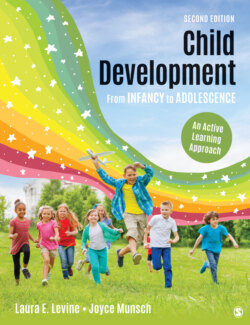Читать книгу Child Development From Infancy to Adolescence - Laura E. Levine - Страница 57
На сайте Литреса книга снята с продажи.
Ages and Stages
ОглавлениеWe use the terms infancy, toddlerhood, early childhood, middle childhood, and adolescence to identify broad periods of development that have behaviors or characteristics that set that stage apart from the other stages. During infancy (the first year of life), children are totally dependent on their caregivers for their physical care, but they already can use all their senses to begin exploring their world. During this period, they begin developing the motor skills they will need to explore it further. They also form a strong emotional attachment to their caregivers and lay the foundation for learning language. Toddlers (ages 1–3) continue developing their motor skills and can more actively explore their physical world. Language develops at an astonishing rate during this period, and toddlers begin showing independence and autonomy from their caregivers as they learn to do things for themselves. In early childhood (ages 3–6), children learn about the physical and social world through play. As peers become more important, young children learn the skills necessary to understand how other people think and feel. During middle childhood (ages 6–12), children develop the intellectual ability to think in a more ordered and structured way and school becomes a major context for development. At this stage, children begin developing a clearer sense of self and an understanding of who they are and what makes them unique. Play and peers are essential parts of their lives. The physical changes associated with puberty mark the transition from childhood into adolescence (ages 12–18). As their bodies undergo the physical changes that move them toward adulthood, adolescents are able to think and reason at a more abstract level and they develop a stronger sense of who they are and who they want to become. Family remains important to them, but peer relationships take on a greater importance than they had before. Although this book covers the stages from infancy through adolescence, we briefly describe a stage that begins in late adolescence: the stage of emerging adulthood (ages 18–25). This stage describes the period of transition between adolescence and adulthood. During this time, many young people feel they are no longer adolescents but also recognize they are not yet ready to fully assume the role of an adult in their culture (Arnett, 2015). It represents a time to explore the possibilities open to them in the realms of education, work, and relationships before committing to choices that will shape their adulthood.
